By 2022, ecommerce revenue in the U.S. alone is expected to reach $638 million . Although there are still sales that happen offline, Forrester predicts that by 2023, 58% of sales will be influenced by online efforts. So, even if the final purchase happens in a brick-and-mortar, most research and influence is happening online.
This is all great news for anyone who owns an eCommerce business, but it also means you've got to find a way to stand out and reach the people that would benefit from your products or services. There are several different ways you can cast a wider net online, but Facebook advertising is a channel that many eCommerce businesses have seen success with.
Let's take a look at why Facebook is a great place to advertise.
Click here to download detailed infographic on tips for creating successful Facebook ads for your eCommerce ads.
Facebook: A Great Advertising Medium For Ecommerce
According to Statista , Facebook has more than 2.7 billion active users — someone that's logged in at least once per month — making it the largest social network in the world. In 2012, Facebook became the first social network to surpass 1 billion active users.
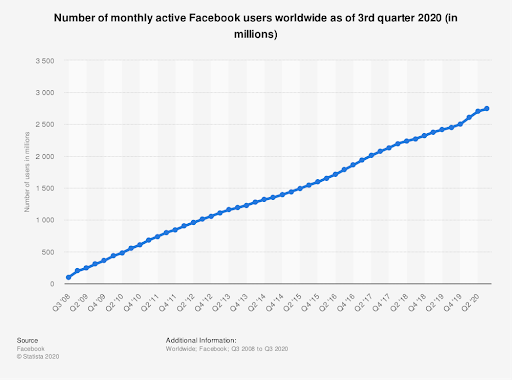
During the second quarter of 2020, Facebook stated that 9 million active advertisers used the social networking platform to promote their products and services. This is an increase from the 7 million advertisers in the first quarter of 2019, according to Statista .
The large user base is one reason businesses choose to advertise on Facebook. Another reason is because of the price. Advertising on Facebook allows businesses to set an advertising budget, and the ad cost won't surpass that number. Of course, the higher your budget is, the more users you're likely to reach.
Let's take a look at some additional reasons to advertise on Facebook. We'll also discuss the types of ads the platform supports and tips for making your ads successful.
1. Expand Online Reach
Using Facebook advertising is a way to grow your audience, complementing your strategy for organic search. For example, the ad will target specific users who will engage with it. Some of those users will likely share the ad — or the boosted post — and your content will organically reach an even wider audience than what you paid for.
You can also use Facebook ads to get more users to follow your Facebook Business page. If the ads target the right demographics, new page followers will interact with your organic posts, too.
Facebook ads can also be utilized to promote an event. This way, the event will show up in a user's newsfeed. All users who decide to go to the event — and RSVP to it — will contribute to your organic reach because the event post will show up on attendees' profiles.
2. Reach Your Target Audience Where They Spend The Most Time
No matter what industry your eCommerce business is in, you've likely got customers that spend time on Facebook. In fact, a survey from Global Web Index showed that people spend anywhere from 45 minutes to 3.5 hours a day on social media.
If your customers are spending time on Facebook, you must have a presence there, too. Since the beginning, Facebook has gathered a wealth of data about its users. It uses this data to help businesses create highly targeted ads and reach potential customers.
By using Facebook for advertising, you'll be able to reach potential customers based on their age, location, gender, industry, job title, interests, and marital status, among other options.
3. Casually Engage Your Target Audience
Many modern audiences are used to seeing traditional forms of social media ads. To reach even the toughest ad critics, Facebook allows businesses to utilize Messenger ads placed right inside a user's Messenger app.
There are standard ads that can be used within the app, but click-to-Messenger ads and sponsored messages. Standard ads are the simplest option and appear to the user just as a sponsored message.
If the user clicks on the ad, they are taken to a conversation involving a set of additional information topics. The twist is, the the conversation happens with a chatbot , so no one has to sit and manage ongoing chats.
With Click-to-Messenger ads, the ad appears in the newsfeed, but a user's click brings them into Messenger for an automated chat .
Sponsored messages provide a way for you to re-engage a user after they've previously interacted with your business. Sponsored messages look like standard, individual messages, and the user can participate in an automated chat.
5 Facebook Ads That Will Help Your Ecommerce Store Make Sales
Even within Facebook, you can use several different types of ads to show off your products and services to potential customers. Certain ad types might be better for your business than others. As you'll find, some ad types will be better for promotions, and others will work for individual products.
1. Carousels with Different Products
A carousel ad allows a business to include up to 10 images for a user to scroll through. This means you can post several different products and/or product details in a single ad.
Like other types of Facebook ads, a carousel ad can be customized to reach specific audiences via messaging and product choices. You can even include video in a carousel ad.
Because of their composition, carousel ads encourage users to scroll through and look at all the images. This increases your customer engagement , ad engagement, and even your ad engagement score. A higher engagement score means a lower Facebook ad cost, a win-win.
For example, this carousel ad from Larq allows users to scroll through different pictures of their latest product.
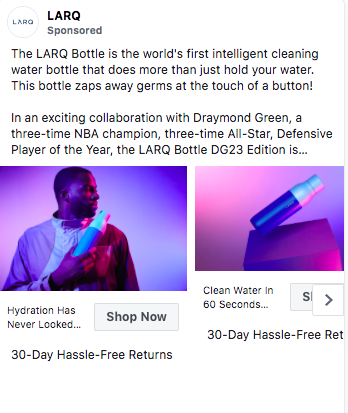
2. Videos. Videos. Videos
Video in any form is a popular way to get people's attention online, and it works in Facebook ads, too.
Facebook suggests you utilize video ads to:
-
Display your product, service, or brand in different ways. Use a video to show unique product features or share your brand story.
-
Grab a user's attention. Create short videos — 15 seconds or less — to captivate your audience and keep them engaged.
-
Deliver one message. Send a clear, simple message that motivates people to take action, such as buying a specific product or visiting your website.
For example, this video ad from Burrow is 15 seconds, and it shows several different products within a single video. It's also sharing information about their current promotion.
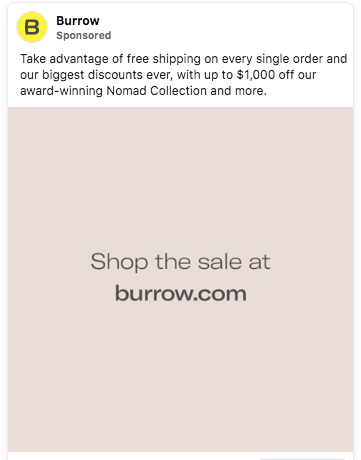
3. Ads That Focus On Promotions
As the name suggests, a promotional ad provides information about an ongoing offer in your eCommerce store.
This type of ad is usually targeted at current customers. These are the people you'll want to offer a promotion to. A promotional ad will provide the customer with a unique code to participate in a sale or a deal when visiting your store.
For example, Bliss's Facebook ad shares a special code for 30% off their larger sizes of products. It's unlikely that a new customer would buy these, so Bliss is targeting previous shoppers.
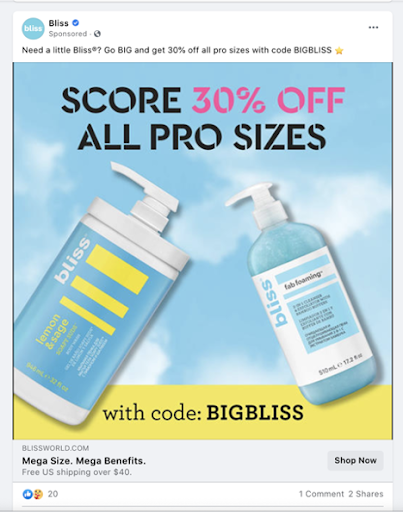
4. Dynamic Product Ads
Dynamic product ads are ads created from an eCommerce store's product feed. These types of ads are the easiest to set up once your product feed is integrated with Facebook.
From there, Facebook puts the ads together using the product image and associated content such as the title, price, and description. Dynamic product ads can also show products customers have previously viewed.
At Statusbrew, we've seen a sharp increase in incoming queries for dynamic ads & dynamic ad comment management, especially from eCommerce merchants, in the last few months.
We took the initiative of doing marketing research on the advantages of dynamic ads for different types of businesses, problems they encounter, and more.
A quick market search pointed out that we are among the only few platforms that offer various dynamic ad comment management features.
Learn more about dynamic ad comment management features offered by Statusbrew.
If you'd like to try out Statusbrew for your business, you can sign up right now & start your free trial.
Statusbrew is an all in one social media management tool that supports Facebook, Instagram, Twitter, Linkedin, YouTube, and even Google My Business.
If your ecommerce merchant supports integration with Facebook ads, that makes the process even easier. But, products can be added manually within Facebook Business Settings.
For example, Skullcandy has several different models and colors, so they use dynamic product ads pulled directly from their product feed.
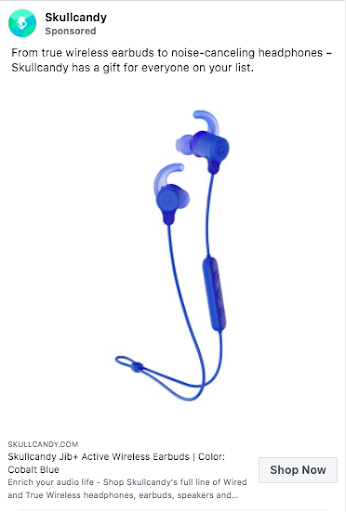
5. Show Off Different Use Cases
Instead of showing just one way to use or style your product, you might have to get creative. Show potential customers the many different ways they'll incorporate this product into their daily lives.
Solo Stove has several different Facebook ads that show the many ways to use their product, whether it's during a camping trip or right at home. Many of their ads are also paired with customer testimonials so a viewer can get a feel for how real people use the product regularly.
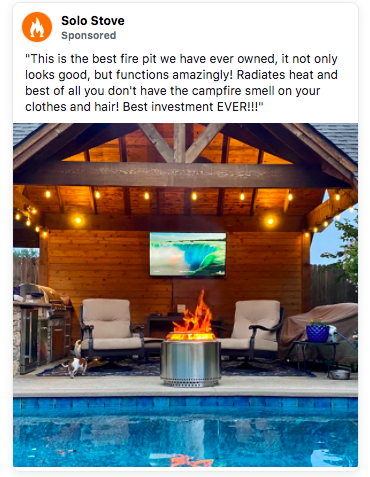
Tips For Creating Successful Facebook Ecommerce Ads
No matter which type of Facebook ad you choose, there are some things you can do to make it successful. Here are some tips for creating ads that convert.
1. Use Stunning Product Images
Having high-quality product photos is a large part of having an eCommerce site that gets customers to purchase items. Without high-quality photos, a potential customer wouldn't have the trust and certainty they need to pay for a product.
As a result, eCommerce businesses should invest in stunning product photos. Depending on the resources you already have within your business, this might mean hiring a photographer or getting the right equipment and taking matters into your own hands.
If you want to take the photos yourself, it's important to learn the proper technique, so you end up with the high-quality photos you want.
Get the right tools
The tools you need will depend on what you already have or have access to. For example, you may not need to buy lighting if your office has a studio or lots of natural light. But you'll need to have a professional camera, a tripod, and lighting.
Obtain great lighting
Without the right lighting, your product may look distorted, and customers won't see any details.
Natural lighting is the best option, so if you have a space with lots of windows or good outdoor space, you can take photos there. Aim to take your photos in the morning to get the best dose of natural light.
If you're selling products with lots of detail, artificial lighting can be better for closeups. Look for lighting with various options for brightness and color—for example, white light vs. yellow light.
Learn about photo editing
Taking great photos is the first step, and knowing how to edit them properly is the second step. There are editing courses, how-to videos, and photo editing tools that provide tips and tricks to help anyone learn to edit photos. It's important to remember that taking quality photos, to begin with, will make the editing process easier.
Understand the Rule of Thirds
The Rule of Thirds is a basic photography principle. The Rule of Thirds begins with an imaginary grid — with nine equal parts — placed over any image. To follow the principle, there should be something eye-catching at each intersection.
This prevents the photo's subject from being completely centered, and it supports the way our eyes are trained to move when looking at the graphic. Venngage has a great social media graphics tool to ensure your designs are top-notch.
Pay attention to other brands
It's never a bad idea to keep an eye on what your competition is doing. You can also keep up with brands with great photos that inspire you when it comes to the images you're creating.
For fashion or food photos, you can get innovative with the styling and the background. But if your products have lots of detail, make sure it's not getting lost in the photo's setting.
Take pictures from several different angles
If you take the time and effort to set up a photoshoot, you should take photos from several different angles. You never know what's going to end up looking great once you start editing. The more photos you take in the beginning, the less likely you'll need to plan a reshoot.
Plus, depending on your product, customers like seeing items from every direction possible. They want to be able to see the product online just as they would if they were in-store.
Don't forget the details
Be sure to capture all of your product's details in the photos. This means the photos need to be large enough for customers to zoom in and get a closer view.
Consider it a rule of ecommerce to leave nothing to the imagination. Customers do lots of research before making a purchase, and looking at photos is a part of that.
2. Add Facebook Pixel For Retargeting
The Facebook Pixel interacts with your eCommerce site by collecting valuable data via a code snippet you install. Once Facebook Pixel is properly installed, it triggers when someone visits your website.
This tool tells you when someone visits your site after looking at one of your Facebook ads. Then, you can reach this customer again through Facebook's custom audience option.
As the Facebook Pixel collects more data, it will help Facebook deliver your ads to a more qualified audience based on those numbers.
3. Make Sure Your Copy Is Compelling
To get the most out of your ad copy, you should follow best practices when creating it. In general, you should always have a goal of showing the customer the value of your products instead of coming across as selling.
Focus on user needs and benefits.
Start writing the ad copy by thinking about your potential customers. Show users the value of what you're offering by considering the customer's needs and how they'd benefit from buying the product.
If you were a customer of your business, what kind of ad copy would get you to click on the ad or visit the website?
Once you've created some ads, you can use data to see what ad copy performs better than others. This information will help you write better copy for future ads.
Use specific and relatable calls to action
It's easy to get sucked into using generic sales phrases (think: "Call us today!") when writing ad copy. But these generic calls to action often result in decreased ad engagement.
Creating urgency is a good approach, as long as there's a valid reason for it, such as the deal ends in three hours. Make sure that whatever action you're asking the user to take will actually benefit them.
When you're coming up with calls to action, make sure they fit where the customer is within the buyer's journey. When would they want to go to your site and look at products? When would they be ready to make a purchase?
Monitor ad insights
Facebook provides data to help you understand how your ads are performing. This information can help you create future ad campaigns.
Within this data, you'll be able to learn more about the people viewing and clicking on your ads. You'll also be able to observe trends over time, whether it's customer trends or a specific time of year.
Conclusion
Facebook offers several tools to help anyone — even someone new to creating ads — set up ads and bring new customers to their website. There are many reasons why so many businesses consistently go to Facebook to advertise their products and services. Set a budget that works for you, and test the waters. Take it one step at a time and use the data to keep improving.
Infographic

Citation Policy: Please feel free to use these infographics in any commercial or non-commercial capacity. If you use the infographics, we require a reference back to Statusbrew Blog.


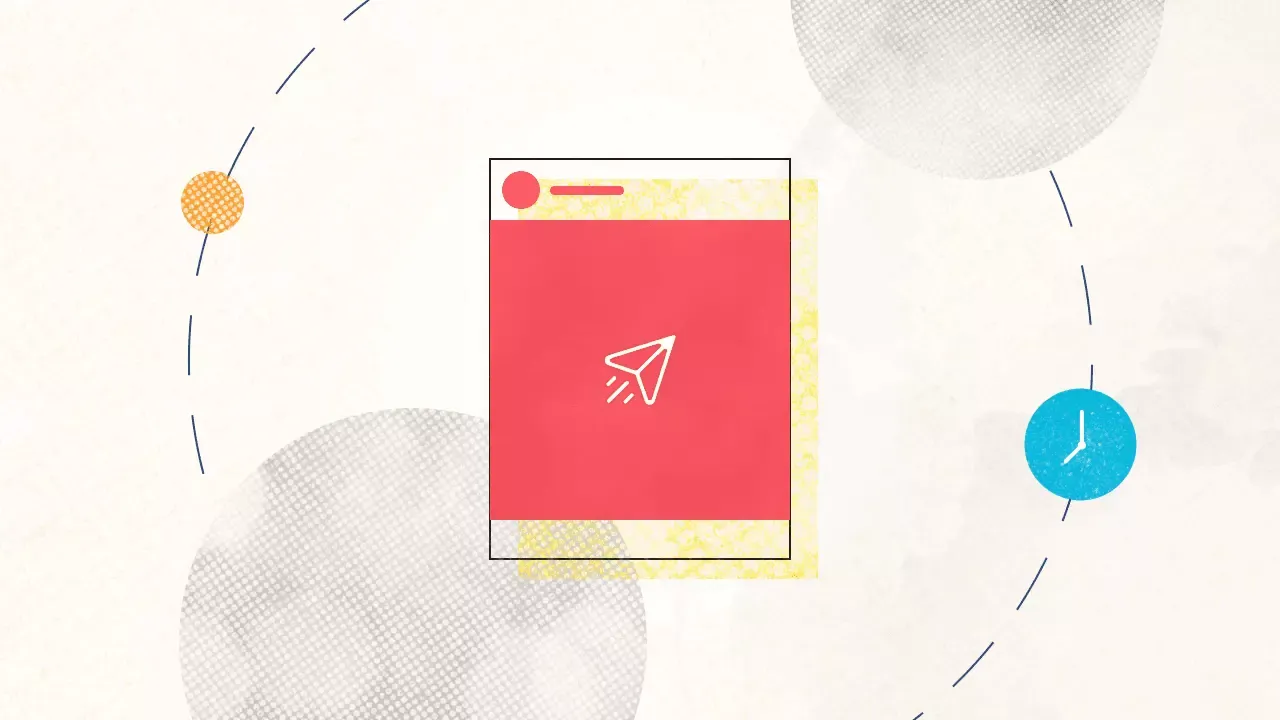

Explore the Statusbrew range of social media tools
Cancel anytime!